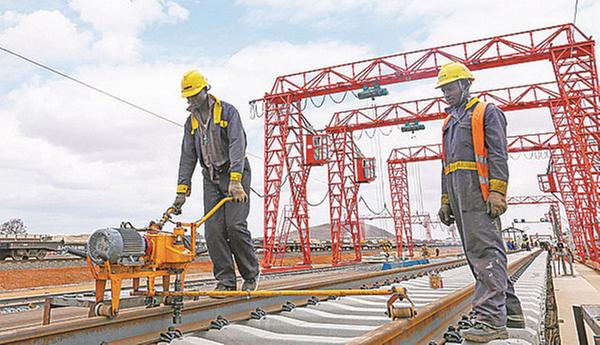Kenya railway a game changer for East Africa

 |
| Workers at the construction site of the Mombasa-Nairobi standard gauge railway in Kenya. Pan Siwei / Xinhua |
In contrast to the meter-gauge railway built more than a century ago during the British colonial rule, the 480-kilometer railway is expected to reduce the travel time from 10 hours to just 4 hours and lower logistics costs by 10 to 40 percent. Built by China Road and Bridge Corporation, Kenya's first standard gauge railway, also the largest infrastructure project since its independence, cost $3.8 billion with China contributing nearly 90 percent of the amount.
The good news for Kenya, however, has been accompanied by speculation by Western observers that the country will struggle to repay the "monstrous" debt at the expense of Kenyan taxpayers. A recent report in The New York Times even drew parallels between the China-funded railway and the "Lunatic Express", a term coined over 100 years ago to describe the costly, all-consuming construction of a colonial British railway linking the Kenyan part of Lake Victoria with Mombasa.
Such a far-fetched analogy and misinterpretation of the Kenyan government's motives to build the railway is nothing but slanderous. The Beijing-backed project provided training opportunities to 45,000 local employees and created more than 46,000 jobs during the four-year construction period, not to mention the proposal to build a technical academy for railways. The Kenyan people were fully involved in the project and stand to greatly benefit from it.
Unlike the 1 billion yuan aid to the Tanzania-Zambia Railway, which was built in the 1970s, Beijing's railway loan to Nairobi has to be repaid. The two countries' partnership to build the Mombasa-Nairobi project has not only helped train some 3,000 local railway technicians and created opportunities for many others to receive such training in the future, but also kept the cost at a controllable level.
Nairobi is confident that the railway will increase its annual GDP by 1.5 percent and the loan will be paid back in about four years. That is achievable if all agreed terms are followed through as designed. China and Kenya have vowed to upgrade the construction of industrial parks along the route while seeking to integrate the Mombasa-Nairobi railway, the Port of Mombasa and the Mombasa Special Economic Zone.
The railway will also stimulate growth and industrialization of neighboring countries, including Uganda and Rwanda, adding fresh impetus to the economic integration of and the flow of people and resources in East Africa.
The lack of connectivity in East Africa has greatly limited cross-border trade between the countries in the region, many of which are heavily reliant on the continent's second largest port Mombasa, keeping prospective investors at bay. The Mombasa-Nairobi railway could well be a game-changer for the more than 120 million people in the six East African countries.
China welcomes the idea of enhancing capacity cooperation with Kenya and other African countries, by contributing its railway expertise and strong record of building infrastructure facilities. Its railway cooperation with Kenya and other African countries has not been without challenges, from transnational coordination to the slow long-term returns on the projects. But that should not stop the parties concerned from taking the right path to share development, nor does it justify the West's attempts to exaggerate the risks.
The author is a senior researcher at the Charhar Institute and a researcher at the Institute of West-Asian and African Studies, Chinese Academy of Social Sciences. The article is an excerpt from her interview with China Daily's Cui Shoufeng.


































